Cristina Badillo is an embroiderer in Spain who creates fantastic pieces of embroidery featuring gold and other metal threads. I’ve gotten to know her work through her blog, Barroco Siglo XXI, or 21st Century Baroque, and through following Cristina on Facebook, where she posts gorgeous close ups of her work.
Recently, I’ve been communicating with Larissa Borodich, a Russian friend who shares a keen interest in goldwork and embroidery as well. She commissioned Cristina to embroider a piece for her, and Larissa sent some close up photos of the piece to me.
So I’d like to share this gorgeous goldwork with you today, for inspiration!
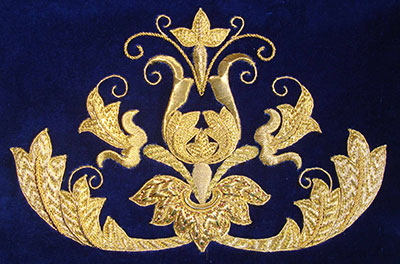
This is Larissa’s goldwork piece, embroidered by Cristina. If you look at the picture that Larissa posted on Pinterest, you can see the piece in much greater detail, and you can click on it for a larger version. While you’re there, try not to get lost in Larissa’s Pinterest boards – she has some unbelievable embroidery pins on there!
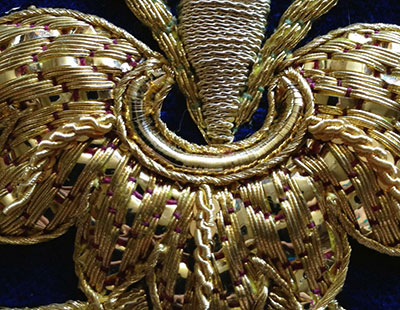
Here, you can see a close-up of the center of the piece. The center of the ring in the middle – the very shiny part of the ring – is worked in strips of gold plate, called broad plate. It’s so beautifully done! I’m not a great lover of working with broad plate, so when I see it in a beautiful applications, it thrills me silly!
In addition to the use of the gold plate on the center ring, you can see it worked on the leaves as well, alternating with couched passing thread in a kind of bargello-like pattern. Lovely use of the plate and the passing thread!
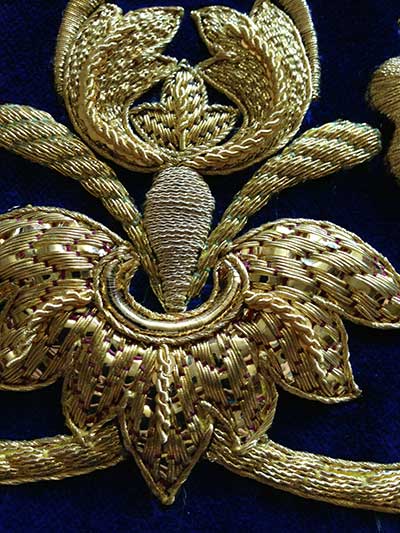
Here, you get a better idea of the combination of the plate and passing thread on the leaves.
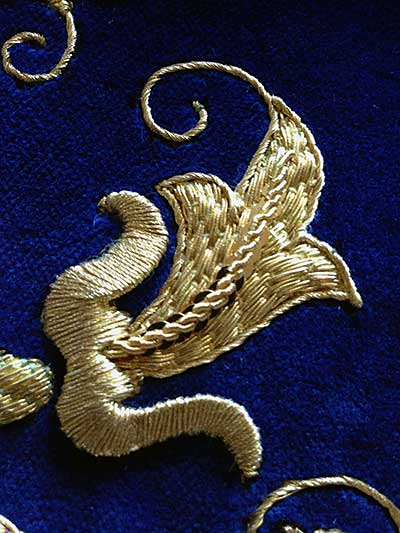
On this leaf, I want to point out the thread outlining the leaf. I’ve seen samples of the threads that Cristina used on the piece – all from a manufacturer in Spain – and most of them have a clear English-goldwork-thread counterpart. But the thread in the photo above that outlines the leaf and continues into the curled tendril does not, to my knowledge, have a readily available counterpart from among the goldwork threads from Benton & Johnson and Golden Threads, which are the two companies that make the more widely available English goldwork threads that we have here in the US.
I’ll show you the particular thread close up later this week, when we talk a little more in-depth about goldwork threads and look at some differences between the English-made goldwork threads and the Spanish-made goldwork threads.
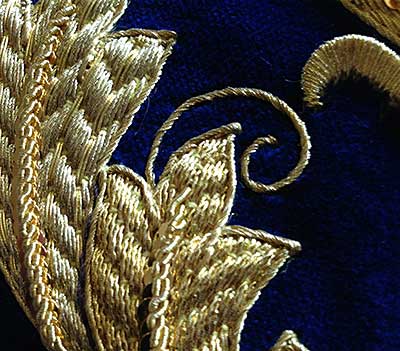
And here again are some other leaves outlined with the same thread. The leaves are worked in rococo (the one on the lower right) and smooth passing (the one on the left), and then, over the “spine” of the leaf is worked a beautiful line of spangles or pailettes, with S-ing a-top them. The rococo thread (a wavy goldwork thread that is couched like passing thread) is slightly different from the rococo thread from England. We’ll look at those differences later this week, as well.
Thanks to Larissa for sending along the photos and the thread samples! More later on this pet subject….
In the meantime, if you’d like a good goldwork “fix,” do visit Cristina Badillo’s blog, 21st Century Baroque, and if you want to be steeped in inspirational photos, check out Larissa’s embroidery boards on Pinterest.







Gosh Mary, Cristina’s Goldwork is sumptuous! I’d love to try doing something like this…think you might try teaching a class like this? I’d sign up in a heartbeat! Thanks for posting this.
Sabrina of Lawrence
WOW! That is all I can say. Thank you for sharing this with us.
Stunning work!
Dear Mary
It must have taken a long time to create such an artistic piece of work, what a collection amazing goldwork, Cristina is certainly a very artistic talented embroider she must be very knowledgeable to know what gold to use in such pieces I would’t have glue. Thanks for sharing this with us and thanks to Cristina for such dedicated inspired work.
Regards Anita Simmance
Thank you for the links. Her work is beautiful.
Unbelieveably beautiful work. Gorgeous. Wow.
I am going to add a little touch of goldwork to a crewelwool picture that I,m working on. Never used gold threads before .The pieces you show here are just amazing! Where can I buy lesser expensive gold threads for beginners please ?
I should never travel through the blogs of embroidery. Not that I am daunted or uninspired! It makes me realize that I must live several lifetimes to try my hand at so many beautiful techniques. It is the same with my horses. I shall never get bored with life!!!
Thank you for sharing such wonderful sites. The work is beautiful.
On the opening page of Cristina’s blog, there is a beautiful heart that has the red and gold background. Could anyone be so kind as to share how that effect might be achieved? For ecclesiastical embroidery, it would be a lovely technique to use as a background with an IHS design. Thanks anyone who might be able to help!
It’s some kind of couched thread I am not familiar with. from a distance I thought “or nue” but zooming in I can see it isn’t quite that. it looks like the gold thread or threads(sorry I don’t know what it is and I can’t even tell if there are one or two of them!) is laid across the padding alongside one of the red threads. another red thread is used to couch down both (as a pair) at intervals. there is one row where the interval of the couching is quite narrow, followed by two rows where the intervals of the couching is longer, which gives a complex “bricking” pattern. the laid/couched threads are then plunged at each end of the row and secured underneath. this is all a bit of a guess without the lady herself revealing her secrets!
Goldwork addict here. Fascinated by the broad plate, I have some in my box of sparklies (just call me a magpie) but I’m rather intimidated by it and, other than filling straight lines with zig-zags, I don’t know enough about its use for it to readily pop into my head at the design stage. so it is sitting there, between the spangles and the rococo (middle row, left hand side) waiting for me to give it a whirl when I am feeling daring!
Wow, Mary. Thanks for this and the links. Can’t wait to see the Spanish threads. Te next thing on my list is improving my goldwork. This is an inspiration. Really can’t wait for the icon embroidery class in Maggie Valley in October. The techniques seem similar, especially the padding.
Cristina’s work is exquisite. I am in total awe, but at the same time I am having a little giggle. This probably comes close to sacrilege but as I was going down the page, in the entry for March 5, 2013, one of the detail shots looks like nothing so much as a fried egg! Yellow circle in the middle surrounded by silvery-white with uneven edges… I am so sorry. I know many of you will think I have lost my marbles entirely, but have another look. Maybe I am not so crazy after all.
I am bringing Cristina Badillo over next February to teach at my Needle Arts Seminar held annually over President’s Day weekend in Texas Hill Country. Would you help me spread the word?